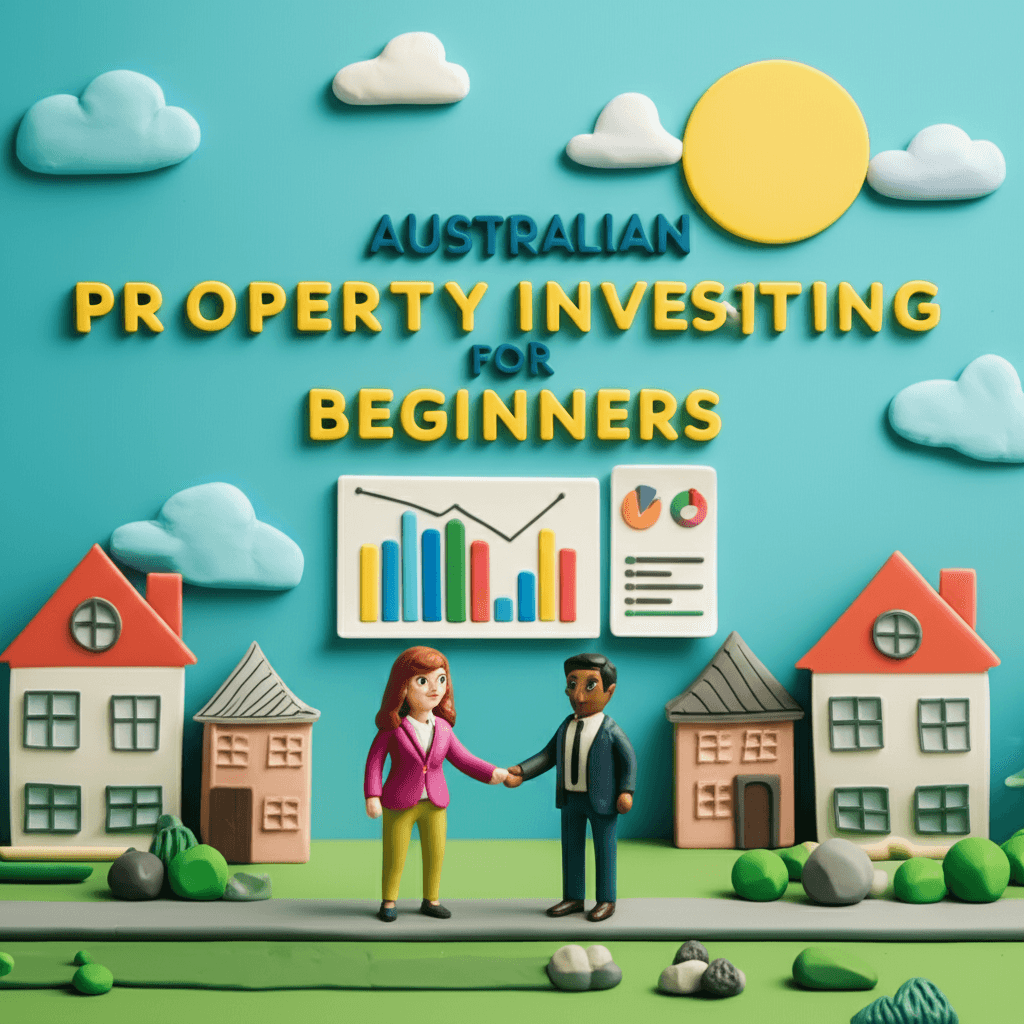Australian Property Investing for Beginners: A Data-Driven Guide
Learn the core concepts of capital growth, rental yield, and leverage to build a successful and resilient real estate portfolio in Australia.

Introduction: Navigating the 2025 Property Landscape
The Australian property market in mid-2025 continues to be a topic of intense discussion, filled with conflicting headlines and complex data. For aspiring investors, cutting through the noise to find a clear path forward can feel overwhelming. The dream of achieving financial security through real estate seems tangible, yet the risks feel equally real. This is where a foundational understanding of property investing principles becomes your most valuable asset.
This guide is designed to demystify the process. We'll break down the essential concepts, terminology, and strategies discussed by industry veterans, transforming conversational insights into a structured framework. Forget get-rich-quick schemes; our focus is on building long-term wealth through informed, data-driven decisions.
Why Australian Property is a Popular Investment Vehicle
Before diving into the numbers, it's crucial to understand why property, particularly in Australia, has remained such a trusted avenue for wealth creation for generations. Unlike more abstract assets, real estate has several inherent advantages that appeal to a wide range of investors.
Tangible and Understandable
One of the most significant draws of property is its physical nature. You can see it, touch it, and understand its function. As humans, we intuitively grasp the value of shelter. This makes property investing more accessible than analysing complex financial instruments like stocks or cryptocurrencies. You don't need to be a market analyst to understand the appeal of a well-located home near schools, transport, and amenities.
Stability and Security
While no investment is without risk, real estate is renowned for its stability. Unlike a company stock that can plummet to zero overnight, a well-chosen property holds intrinsic value in the land it sits on and the shelter it provides. Historically, the Australian market has shown remarkable resilience, weathering economic downturns and consistently trending upwards over the long term. This provides a level of security that is hard to find elsewhere.
Control and Value-Add Potential
As a property owner, you are in the driver's seat. You have direct control over your asset, a luxury not afforded to shareholders who are passive participants in a large corporation. You can actively increase the value of your property and its income potential through various strategies:
Renovations: A strategic cosmetic update or a significant renovation can substantially boost both the property's capital value and its rental appeal.
Subdivision: A large block of land could potentially be subdivided, creating a separate title that can be sold or developed.
Development: Knocking down an old dwelling to build a duplex or townhouses can dramatically increase yield and equity.
Favourable Leverage and Financing
Leverage is arguably the most powerful wealth creation tool in property investing. It is the ability to use borrowed capital to increase the potential return of an investment. Banks are willing to lend a significant portion (often 80% or more) of a property's value because they view real estate as secure collateral. This allows you to control a large, appreciating asset with a relatively small initial capital outlay, amplifying your returns significantly.

Mastering the Core Concepts of Property Investment
To succeed, you must move beyond emotion and learn to speak the language of numbers. A data-driven approach is essential for identifying opportunities and mitigating risks. At HouseSeeker, our entire philosophy is built on using powerful real estate analytics to empower investors to make decisions with confidence. Here are the fundamental concepts you must master.
Capital Growth
Capital growth, or appreciation, is the increase in your property's value over time. This is the primary way long-term wealth is built in real estate. For example, if you purchase a property for $500,000 and its market value increases to $700,000 in five years, you have achieved $200,000 in capital growth. This growth remains untaxed until you decide to sell the property.
Rental Yield
Rental yield is a measure of the income your property generates relative to its value. It's calculated by taking the annual rental income and dividing it by the property's value, expressed as a percentage.
Example: A $500,000 property that rents for $500 per week ($26,000 per year) has a gross rental yield of 5.2% ($26,000 ÷ $500,000).
While high capital growth is often the main goal, a healthy rental yield is crucial for covering costs and maintaining holding power.
Cash Flow (Positive vs. Negative)
Cash flow is the difference between the income your property generates (rent) and all of its expenses (mortgage interest, council rates, insurance, maintenance).
Positive Cash Flow: The income is greater than the expenses, leaving you with surplus cash in your pocket each month.
Negative Gearing (Negative Cash Flow): The expenses are greater than the income, meaning you must contribute your own money to hold the property. While this results in a net loss, in Australia, that loss can often be claimed against your taxable income, reducing your overall tax bill. However, it's crucial to remember that a tax deduction is only a partial reimbursement of a real financial loss.
Leverage in Action
Let's revisit the power of leverage. Imagine you have $120,000 to invest.
Scenario A (No Leverage): You invest $120,000 in a share portfolio that grows by 10% in one year. Your investment is now worth $132,000, a gain of $12,000.
Scenario B (Leverage): You use your $120,000 as a deposit and to cover costs for a $500,000 property. The property value also grows by 10% in one year. The property is now worth $550,000. Your initial investment has generated a capital gain of $50,000. That's a 41.6% return on your initial cash outlay, demonstrating how leverage can supercharge your growth.
Equity
Equity is the portion of the property you truly own. It's calculated by subtracting the outstanding mortgage debt from the current market value of the property. As you pay down your loan and the property's value increases, your equity grows. This equity can then be used as a deposit to purchase your next investment property, a strategy known as 'recycling equity'.
Depreciation
Depreciation is a non-cash tax deduction that accounts for the ageing and wear and tear of a building and its fittings over time. A quantity surveyor can prepare a depreciation schedule that allows you to claim a loss in value against your taxable income, even though you haven't spent any actual money. While this can improve your cash flow, be wary of buying a property solely for its depreciation benefits (e.g., brand new apartments), as these assets may underperform in capital growth.
[INSERT_IMAGE: "A vibrant chart showing capital growth trends in major Australian cities over a 30-year period."]
Is Property Investing Right for You?
Despite its benefits, property investing is not a one-size-fits-all solution. It requires a specific financial position and mindset. Before you dive in, conduct an honest self-assessment.
Financial Stability and Cash Flow
Do you have a stable income and a consistent savings habit? Lenders will want to see a strong track record of financial discipline. Crucially, you need to have a financial buffer. If interest rates rise or the property is vacant for a period, you must be able to cover the costs without financial stress. If you are not currently saving money each month, you may not be ready to take on the financial responsibility of an investment property.
A Long-Term Mindset
Property is a long-game. You will not get rich overnight. The market moves in cycles, and there will be periods of flat or even negative growth. Success comes to those who have the patience to hold their assets for the long term (typically 10+ years), allowing time for capital growth to compound and ride out any short-term volatility.
Risk Tolerance
While property is considered a 'safe as houses' investment, it is not without risk. You are taking on significant debt and are exposed to market fluctuations. You must be comfortable with this level of financial commitment and have the emotional resilience to not panic-sell during a market downturn.
The Investor's Edge: Outperforming the Market
Interestingly, analysis has shown that many properties owned by investors have historically underperformed those owned by owner-occupiers. This is often because novice investors chase high rental yields in inferior locations or are sold poor-quality assets by marketers.
The successful investor has an edge: they make decisions based on data, not emotion. Owner-occupiers often buy with their hearts, focusing on lifestyle factors. Investors can compete in this market by focusing purely on the financial drivers of growth. By using advanced real estate analytics, you can identify suburbs with strong underlying fundamentals—like high demand, low supply, and economic drivers like population growth, as tracked by the Australian Bureau of Statistics (ABS)—giving you a significant advantage.
Conclusion: Your Path to Property Success
Embarking on your property investment journey is one of the most significant financial decisions you will ever make. It's a proven path to long-term financial freedom, but it demands preparation, education, and a clear strategy. By understanding the core principles of capital growth, yield, and leverage, and by committing to a data-driven approach, you can move past the headlines and build a portfolio that serves your financial goals for decades to come. The key is to start with a solid foundation of knowledge, a stable financial base, and a long-term perspective.
Ready to move from theory to action? Explore how HouseSeeker's powerful [real estate analytics](https://houseseeker.com.au/features/real-estate-analytics) can help you identify high-growth suburbs and make investment decisions with confidence.
Frequently Asked Questions
What's the difference between capital growth and rental yield?
Capital growth is the increase in the property's value over time, which you realize when you sell. Rental yield is the income the property generates from rent, calculated as a percentage of its value. A balanced strategy often involves seeking a property with strong growth potential and a reasonable yield to help cover holding costs.
How much of a deposit do I need to start investing?
Typically, you will need a 20% deposit to avoid paying Lenders Mortgage Insurance (LMI). On top of this, you'll need funds to cover purchase costs like stamp duty, legal fees, and inspections, which can amount to an additional 4-5% of the purchase price. For a $500,000 property, you might need around $120,000 in total.
Should I use an interest-only loan for an investment property?
Interest-only loans can be a strategic tool for investors as they lower your mortgage repayments, improving cash flow. This extra cash can be held in an offset account as a buffer or used for other investments. However, you are not paying down the principal loan balance. It's essential to have a clear strategy and discuss your options with a qualified mortgage broker. For a more personalized approach to structuring your finances and finding the right property, a tool like our AI Buyer's Agent can provide guidance tailored to your goals.
